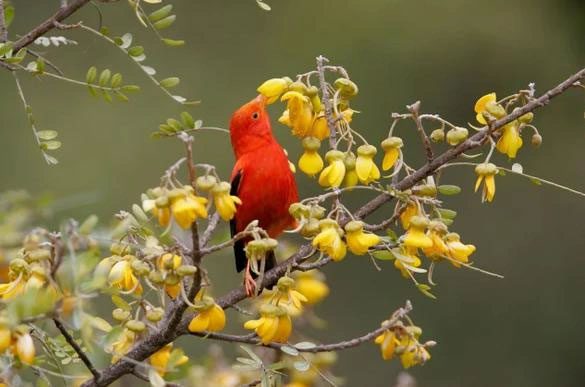The brightly colored honeycreeper species in Hawaii is at risk of extinction due to introduced predators, habitat destruction, and disease.
“Symbol of Hawaii” in Danger
The brightly colored honeycreeper is considered an iconic bird of the Hawaiian Islands (USA). These small birds have evolved over millions of years, adapting uniquely to the habitats on the islands of Hawaii. They play a crucial role in pollinating many plant species in Hawaii.
Over 50 species of honeycreepers once flew throughout the archipelago, but due to introduced predators, habitat destruction, and disease, that number has dwindled to just 17 species.

Iiwi (Vestiaria coccinea), a common Hawaiian honeycreeper that feeds on nectar, can only be found in the high mountain forests of the Hawaiian Islands – (Photo: ALARMY STOCK).
One of the specific threats to honeycreepers is the mosquito Culex quinquefasciatus – an invasive species that arrived on the islands in water barrels on European ships in the early 19th century. This mosquito spreads the malaria parasite, which is lethal to birds.
The honeycreepers that still exist today survive by living in high mountainous areas, where the cooler temperatures keep mosquitoes at bay. However, rising temperatures are expanding mosquito habitats, and each year they are moving higher up the mountainsides, causing disease and death among bird populations.
Four species of honeycreepers, including Akekeʻe and Akikiki on the island of Kauai, Kiwiki and Ākohekohe on the island of Maui, are in particularly dire straits. They could face extinction this year if no action is taken to save them.
Ms. Hanna Mounce, director of the Maui Forest Bird Recovery Project, stated: “With the warming climate, we will have no more of these birds left.”
“Using Poison to Combat Poison”
The Maui Forest Bird Recovery Project is hopeful of saving honeycreepers by “using mosquitoes to combat mosquitoes.”
Like many other arthropod species, the mosquito Culex quinquefasciatus contains natural Wolbachia bacteria in its gut. For mosquitoes to reproduce, they must mate with individuals infected with the same strain of bacteria.
Scientists will release male mosquitoes carrying a different strain of Wolbachia than that found in Maui. The native female mosquitoes will mate with these males, but because the Wolbachia bacteria from both sides are incompatible, they will be unable to produce offspring. This means that the “population” of Culex quinquefasciatus on the island will dramatically decrease.
Starting this November, the project team will release 250,000 mosquitoes and will continue to release them twice a week over approximately 1,215 acres in eastern Maui for one year. The mosquitoes will be released from helicopters in biodegradable capsules the size of mangoes, each containing about 1,000 mosquitoes.
“We know this is not a long-term solution. But it is a currently available solution,” said Ms. M. Renee Bellinger, a geneticist at the U.S. Geological Survey.
If the project fails, it may be necessary to relocate the honeycreeper species away from areas infested with disease-carrying mosquitoes, according to Mr. Sam ‘Ohu Gon III, a senior scientist and cultural advisor at the Nature Conservancy.


















































